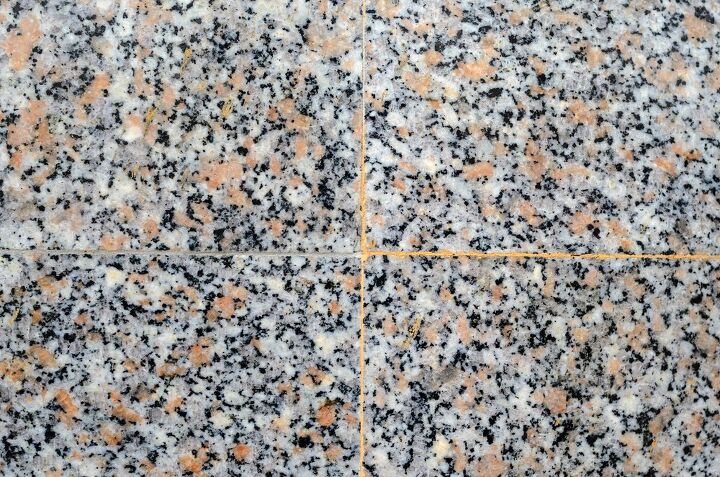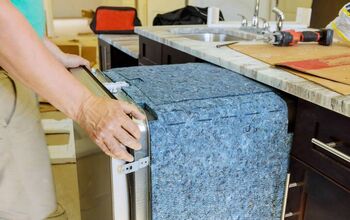Are Seams Ruining Your Granite Countertop? (We Have a Fix!)

Granite is one of the most luxurious and durable natural materials for countertops. Most granite countertops have seams to fit the material onto the cabinets. Seams of a well-designed granite countertop are practically invisible, so what should you do when the seams are obvious?
Seams ruin the high-end aesthetics of granite countertops. Paint the seams. Smooth granite countertop seams with fine-grit sandpaper. Repair damaged seams by removing the old epoxy with a putty knife. Fill the entire seam from the wall to the front edge with new epoxy, polyester glue, or silicone caulk that contains epoxy. Tint the sealant to match your countertop.
Let’s look at how granite countertops are made and why they have seams. Then we’ll delve into how to fix common problems with granite countertop seams.
Do You Need Stone and Granite Countertop Repair?
Get free, zero-commitment quotes from pro contractors near you.

How Granite Countertops are Made
Like other types of rocks, granite is mined from a quarry. The best granite comes from Brazil and Italy, but you can also find granite from India and China. Brazil is known for granite with exceptional color, such as Van Gogh granite that has a striking blue color. Most of the granite that is used in the United States comes from either India or Brazil.
The granite is removed from the ground in large pieces and milled into slabs. The slabs are typically 7’ to 10’ long. The slabs are then sliced to the proper thickness – 1 1/4” for kitchens and 3/4” for bathrooms. The granite is buffed and polished to a high gloss sheen.
When you shop for granite countertops, the showroom features semi-finished slabs. Once you choose a slab, it is cut to fit the cabinets of your kitchen or bathroom. The shape or length of the original slab may not marry up with your kitchen cabinets, or the slab may have some significant defects. In these cases, the fabricator cuts the slab into smaller pieces. This ensures that the pattern of the granite is continuous across the entire countertop, with the exception of corner seams.
When the countertop is installed, there is a seam where the smaller pieces fit together. The installer uses a special resin to connect the pieces of the countertop.
Pros and Cons of Granite Countertops
Despite the additional expense of granite countertops, the material continues to be one of the most desirable for kitchens and bathroom.
Pros of Granite Countertops
- Impressive aesthetic
- Durable
- Easy to clean and resistant to bacteria, mold, and stains
- Plenty of shades to choose from
- Each slab is unique
- 3 grades – relatively budget-friendly
Cons of Granite Countertops
- More expensive than soapstone, laminate, engineered quartz, and porcelain
- Cutting directly on granite dulls knives
- Difficult to match vein patterns in corners and U-shaped kitchens
- Seams may be needed to fit larger spaces and unusual shapes
- Porous material – requires sealing
Where Should Seams Be in Granite Countertops?
Granite countertop seams should be positioned so that the countertop has a consistent look.
- Inconspicuous areas, such as corners
- Aligned with cabinet frames – never over openings for sinks, dishwashers, and other appliances
- At least 6” from sink cut outs
- Approximately 1/16” thick
Granite Seams in a U-Shaped or L-Shaped Kitchen
Corners are the best places to put granite countertop seams for a U-shaped or L-shaped kitchen. The slabs have good support, and corners are used less often than the rest of the countertop.
What Should Granite Seams Look Like?
The acceptable look for a granite seam is a smooth, even surface that is completely flush with the countertop. There shouldn’t be any gaps between the sealant and granite. Gaps in the sealing material are the perfect place for bacteria, mold, and little bits of food.
The best materials for sealing granite countertop seams are polyester glue and epoxy. Some installers use silicone to allow shifting of the slabs. If you prefer a silicone material, choose one that is a blend of silicone and epoxy.
5 DIY Fixes to Make Granite Countertop Seams Disappear
If your granite countertop seams are more noticeable than you like, there are ways to make them disappear, or at least be less visible. Here are some ways for how to make granite seams disappear.
Seam Color Doesn’t Match Granite Countertop
If you have a smooth, even seam in your countertop that doesn’t match the color of the granite, there’s an easy fix. Paint the seam. Use a product that works on epoxy, polyester glue, and silicone. Choose a color that matches the primary color of the granite. If the seam intersects veins in the granite, use different colors to blend the seam with the veins.
Granite Seams at Sink
Granite seams at the sink are not ideal. Before you try to hide the seams, have the installation checked by a professional. If the slabs are secure, remove the from the seams with a putty knife. Fill the seam with epoxy that matches your granite.
Granite Seams Coming Apart
Make sure that the granite slabs are supported before you fix seams that are coming apart. Remove the remaining epoxy with a putty knife. Fill the seam with epoxy or polyester glue.
Uneven Granite Seams
Use fine-grit sandpaper to smooth out the surface of the seam. Fill indentations with epoxy.
Damaged Seams
Replace damaged seams in granite countertops. Check that the slabs are supported by the frames of the kitchen cabinets. Remove the epoxy with a putty knife. Fill the seam with epoxy, polyester glue, or a silicone-based caulk that contains epoxy.
How to Seal Granite Seams
Seal granite seams with epoxy, polyester glue, or a silicone-based product that contains epoxy. Use a putty knife to remove the sealant between the slabs. Fill the space with the epoxy with a back-and-forth motion. Make sure to fill the entire gap from the wall to the edge of the granite, including the front edge. Use a damp cloth to clean up any epoxy that gets on the countertop. After the epoxy sets and dries, use a razor blade to remove epoxy that is on the countertop. Be careful to not nick the epoxy in the seam.
How to Separate Granite Seams
If you decide to take on a DIY project and change out your granite countertops, you will need to separate the slabs at the seams. Put a putty knife against the edge of the granite countertop to loosen the seam from the finished edge of the granite. Lift the epoxy out of the seam with the putty knife.
Related Questions
What is the best way to clean granite countertops?
Dampen a microfiber cloth in a mixture of warm water and a few drops of mild dish soap. Dry the countertop with a second microfiber cloth. Remove stains with a paste made from baking soda and water. Apply it with a microfiber cloth using a gentle, circular motion.
Is granite or quartz better for a countertop?
Granite is available in more colors than quartz, and it has a slightly lower price point. Both materials are easy to maintain. Granite and quartz are both very durable stones. Unlike granite, quartz is not porous. Granite is more heat-resistant than quartz.
Should granite countertops be sealed?
Yes. Sealing a granite countertop prevents the stone from absorbing moisture, bacteria, food particles, and mold spores.
Do You Need Stone and Granite Countertop Repair?
Get free, zero-commitment quotes from pro contractors near you.

Summing It All Up
Granite is one of the most durable and appealing materials for kitchen and bathroom countertops. Large granite pieces are extracted from quarries, and milled to the correct thickness and length.
The raw slab that you choose may not be the length or shape for your cabinet design, or there may be significant flaws in the material. In these cases, a fabricator cuts the slabs before installation. The slab may be cut into smaller pieces.
During installation, the slabs are laid out on your cabinets. Seams are the spaces between two slabs. The seams are filled with epoxy, polyester glue, or a silicone-based product that contains epoxy.
Ideally, granite countertop seams should be invisible. The best places to put seams are in corners and above the frames of cabinets. Seams should never be positions over openings in the cabinets, such as the space for the dishwasher. Leave at least 6” between a seam and sink cutout. Granite countertop seams should be about 1/16” thick.
If the seam filler does not match your countertops, paint it the same color as your countertop. Use a product that works with epoxy.
Fix the seams with the same product that was used during the installation. If the seam is uneven, use a fine-grit sandpaper, and fill in the indentations with a seam sealing product.
For seams that feel rough, use fine-frit sandpaper to smooth out the surface. Avoid sanding the countertop. This damages the granite sealant.
Replace damaged seam filler. Make sure that the slabs are supported, and remove the old epoxy with a putty knife. Fill in the space with epoxy, polyester glue, or a silicone caulk that contains epoxy.
When you apply epoxy to a granite countertop seam, use a consistent back-and-forth motion. Make sure to fill the seam all the way to the wall, as well as the front edge of the countertop. Remove excess epoxy with a damp cloth. Once the epoxy sets and dries, use a razor blade to clean any epoxy residue on the countertop.

Jennifer L. Eggerton loves being hands-on, whether it's with a home DIY project, making repairs, re-decorating a room, or keeping life organized. She enjoys helping people by sharing her knowledge, insights, and experiences, as well as her lessons learned. In addition to her work as a writer, Jennifer is a Jeep® overlander, self-published author, and nature photographer who loves being outdoors.
More by Jennifer Eggerton



























